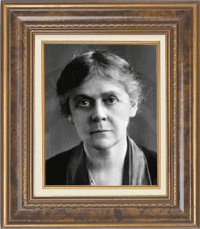|
Home > Healthy Living >
Women Inspiring Hope and Possibility > Alice Hamilton
Alice Hamilton
(1869-1970)
LINKS ON
THIS PAGE
Overview
Education and Training
Career Path
Selected Achievements
Occupational Health and Safety Today
CDC's Role
Tips to Reduce Your Risk for Hazardous Exposure at Work
Related Links
Overview
Alice
Hamilton was born in New York, New York in 1869 and raised in Indiana. She
made significant contributions through her work in occupational medicine.
She died in 1970 at the age of 101.
Education and Training
- Degree at
Fort Wayne College of Medicine in Indiana
- Medical
degree from the University of Michigan
-
Internships in Minneapolis and Boston
- Attended
universities of Munich and Leipzich in Germany for a year with her sister,
Edith Hamilton
- Neither
university had admitted females before, so she was permitted to attend
lectures in bacteriology and pathology as long as she made herself
inconspicuous to male students and professors
Career Path
- Researcher
at Johns Hopkins University in Maryland
- Professor
of pathology at the Women’s Medical School of Northwestern University in
Illinois
-
Bacteriologist at the Memorial Institute for Infectious Diseases
- Director
of the Occupational Disease Commission
- This was
the first such commission in the world.
- Several
worker’s compensation laws were passed in Illinois.
- Assistant
professor of industrial medicine at Harvard Medical School in
Massachusetts
- She
became the first woman on the faculty of Harvard University and was not
permitted to use the Faculty Club, to access football tickets, or march
in commencement processions.
- She
became a faculty member of Harvard's School of Public Health.
- Consultant
for the Division of Labor Standards of the U.S. Labor Department
Selected Achievements
-
Established medical education classes and a well-baby clinic while staying
at the Jane Addams's Hull House
- Made a
connection between improper sewage disposal and the role of flies in the
transmission of typhoid fever
- Pioneered
occupational epidemiology and industrial hygiene in the US, beginning with
investigations of lead poisoning among bathtub enamellers
- This
resulted in a series of reforms to reduce occupational exposure to lead.
- Studied
carbon monoxide poisoning in steelworkers, mercury poisoning in hatters,
and "dead fingers" syndrome among laborers using jackhammers
- Introduced
the idea of worker’s compensation for disease and injury sustained on the
job
- Replicated
her research on a national level in an unsalaried position after being
asked by the US commissioner of labor
- Examined
hazards from exposure to lead, arsenic, mercury, organic solvents, and
radium (used in the manufacture of watch dials).
- Became the
first woman to receive the Lasker Award in Public Health
Occupational Health and Safety Today
Each day, an
average of 9,000 U.S. workers sustain disabling injuries on the job, 16
workers die from an injury suffered at work, and 137 workers die from
work-related diseases. The Liberty Mutual 2002 Workplace Safety Index
estimates that direct costs for occupational injuries in 1999 rose to $40.1
billion, with indirect costs reaching over $200 billion.
CDC's Role
CDC continues
to build on the work done by Alice Hamilton. CDC helps assure safe and
healthful working conditions for men and women by providing research,
recommendations, information, education, and training in the field of
occupational safety and health. Activities include:
- Conducting
research to reduce work-related illnesses and injuries
- Promoting
safe and healthy workplaces through interventions, recommendations, and
capacity building
- Enhancing
global workplace safety and health through international collaborations
Tips to Reduce Your Risk for Hazardous Exposures at Work
- Receive
proper training and follow guidelines. Employers are responsible for
training and protecting their workers. Employees are responsible for
learning about the hazards in their workplace, using personal protective
equipment, and following proper work practices.
- Use
personal protective equipment. Gloves, respirators, personal
protective clothing, and other equipment can reduce exposures to workplace
hazards.
- Store
hazardous substances properly. Store chemicals in sealed containers
when they are not in use. Be sure to follow guidelines for the storage of
certain substances.
- Review
material safety data sheets (MSDSs) for all hazardous materials used in
your workplace. Employers are required to have copies of MSDSs and to
provide them to workers upon request. If you are concerned about any
hazards, discuss them with your health care provider.
- Prevent
home contamination. Change out of contaminated clothing and wash with
soap and water before going home. Store street clothes in a separate area
of the workplace to prevent contamination. Wash work clothing separately
from other laundry (at work if possible). Avoid bringing contaminated
clothing or other objects home. If work clothes must be brought home,
transport them in a sealed plastic bag.
Related Links
Agency for Toxic Substances and Disease
Registry
http://www.atsdr.cdc.gov
Alice Hamilton*
http://www.distinguishedwomen.com/biographies/hamilton-a.html
Alice Hamilton,
History*
http://www.cdc.gov/niosh/hamilton/hamhist.html
CDC's National Center for Environmental
Health
http://www.cdc.gov/nceh
CDC's National Institute of
Occupational Safety and Health (NIOSH)
http://www.cdc.gov/niosh/homepage.html
Effects of Workplace Hazards
on Female Reproductive Health*
http://www.cdc.gov/niosh/99-104.html
Women's Safety and Health
Issues at Work
http://www.cdc.gov/niosh/topics/women/
Work-Related
Injury/Occupational Injury
http://www.cdc.gov/nchs/fastats/osh.htm
Reproductive Health Issues
at Work
http://www.cdc.gov/niosh/topics/repro/
*Used as a
source for this Web page.

 This site contains documents in PDF format. You will need Adobe Acrobat Reader
to access the file. If you do not have the Acrobat Reader, you may download a
free copy from the
Adobe Web site.
This site contains documents in PDF format. You will need Adobe Acrobat Reader
to access the file. If you do not have the Acrobat Reader, you may download a
free copy from the
Adobe Web site.
Home | Site Map |
Contact Us
Privacy Policy |
Disclaimer | Accessibility
CDC Home |
Search |
Health Topics A-Z
This page
last reviewed March 24, 200 5
URL: http://www.cdc.gov/women/owh/history/hamilton.htm
US
Department of Health and Human Services
Centers for Disease Control and Prevention
Office of Women's Health
|


